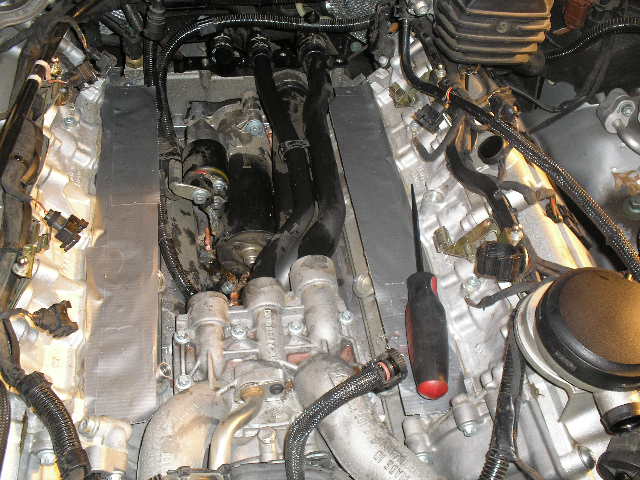Ur-Turn: Not Your Grandmother's Nylons
In early 2011, a class action lawsuit was filed against Porsche alleging that the company knowingly installed defective coolant pipes made of nylon into engines of Cayenne model SUV’s. Apparently, the pipes are very likely to fail prematurely resulting in serious engine damage. If the vehicle is out of warranty, customers end up spending big bucks to repair their engines and replace the coolant pipes. The replacement coolant pipes are made of aluminum.
Most of the readers here probably know that this is not the first time that plastic coolant fittings have failed in a spectacular fashion. In the early 2000’s Ford settled a class action lawsuit brought by owners of various vehicles that had 4.6L V-8’s with intake manifolds made of Nylon. These intake manifolds failed at the coolant passage. The intake manifold was replaced with a new design in which the coolant passage was made of… you guessed it, aluminum.
DuPont was at the forefront of the drive to use Nylon, specifically Glass Fiber reinforced Nylon 6/6 for engine parts starting with radiator end caps which were first adopted by Ford in 1986. Later, in 1996, the first intake manifolds manufactured from the same material started appearing on cars. Nylon intake manifolds have since become ubiquitous and I think that the technology is proven at this point. There are several advantages of using plastic in place of steel or aluminum for intake manifolds. The plastic intake manifolds are lighter weight, the passages can be made smoother which helps deliver fuel more efficiently and probably the number one reason is that they keep the fuel cooler helping the engine run better.
The nylon is typically glass fiber reinforced containing 30-35% by weight what is called “short glass fiber” in the industry meaning that the fibers are approximately 1/16 inches long. The glass fiber adds enormous tensile strength and rigidity to the material. Unreinforced nylon 6/6 has a tensile strength of approximately 12,000 psi while 35% glass fiber reinforcement bumps the tensile strength up to roughly 28,000 psi. This is approaching the tensile strength of some softer grades of steel. Nylon by itself would not bond to glass very well. To facilitate the marriage of these two materials, the glass fiber is coated with proprietary “coupling agents” that allow the nylon to bond to it.
Compared to standard glass fiber reinforced grades of nylon, the anti-freeze resistant grades use better coupling agents as well as heat stabilizers to help the plastic hold up to the elevated temperatures better. The anti-freeze and the organic acids that have been added to anti-freeze in recent years as corrosion inhibitors are thought to attack the bond between the glass fiber and the nylon thus weakening the material.
Whatever is going on chemically, one thing is for sure, the damage done to the nylon over time is severe. A little perusing of the DuPont website revealed a little bit of data on the affects. First to be clear, nylon materials are typically tested in what is called a “dry as molded” condition. The properties of nylon are severely affected by humidity, so in order to maintain some consistency of test results, testing is always performed on specimens that are taken right off of the molding machine and sealed into air tight containers. Here is what we would expect for tensile strength dry as molded and then after being exposed to a 100% relative humidity environment and then finally after prolonged exposure to engine coolant.
Typical Nylon 6/6 35% Glass Fiber Reinforced Tensile Strength
Dry as molded at 23C 29000 psi
24 hrs at 100% relative humidity at 23C 11600 psi
24 hrs at 100% relative humidity at 130C 8265 psi
1000 hrs exposure to 50/50 Zerex® at 130C 5800 psi
5000 hrs exposure to 50/50 Zerex® at 130C 1450 psi
As you can see exposure to the anti-freeze has a significant impact on the properties of the material and this is under ideal conditions. Molded test specimens are designed to produce consistent test results and do not typically have the molding variations that will be experienced in production parts that are cranked out by the tens of thousands. These parts can have significantly lower properties than we see here.
I suppose an automaker could make the claim that these parts are considered wear items and must be replaced as part of regular maintenance. But, I would suggest that a customer buys a car with the expectation of not having to replace major engine components for a reasonable length of time. Furthermore, any components whose failure will cause catastrophic damage to other engine components should be built to last a very long time. Unfortunately, the history and the data seem to indicate that the plastics that are currently being used for parts exposed to engine coolant are not really suitable.
More by Ur-Turn
Latest Car Reviews
Read moreLatest Product Reviews
Read moreRecent Comments
- ToolGuy There was a time when in a place called America there were roads, and they were paved, and they were paved smoothly enough for a vehicle like this. Perhaps our next President will bring back that concept.
- ToolGuy I suppose I will listen before commenting. (TG, what a fair-minded dude!)
- ToolGuy "The technology is much more advanced to be better than a role model driver,”• Do any of you know what a "role model driver" is? No, I guess you wouldn't. 😉
- ToolGuy I might be Batman.
- Lou_BC Well, I'd be impressed if this was in a ZR2. LOL



































Comments
Join the conversation
Articles attempting to have an intelligent discussion on engineering are most welcome. Keep it up.
I would also like to concur with those who have indicated a desire to see more articles liked this on TTAC. I find it quite fascinating.